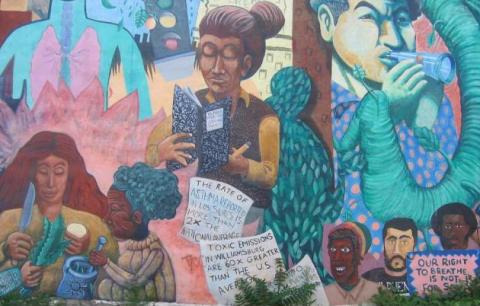Discussion:
Until fairly recently, it was a commonly held notion in the United States that "the people owned the airwaves." Although that notion has apparently vanished from the minds of many politicians and government regulators, people periodically reassert this right when other routes have failed.
With few exceptions, access to media is generally blocked to citizen and, especially, alternative viewpoints. The choices of media often boil down to state-run media (often propaganda) or purely commercial (or a combination of the two) or none at all.
In the US particularly but in other countries as well people are bombarded with images and ideas that are generally cut from the same cloth. Whether news, "reality" shows, police dramas, talk shows, or commercials television is a seamless and impenetrable wall that is assiduously protected from invasion. Media Intervention is one tactic to fight this particular and ubiquitous form of censorship. In this case, the media truly is the message: while the content itself is commercialistic, addicting, intellectually and psychologically (and emotionally? and politically?) stultifying (debilitating?), the sheer immensity and second order effects of the media as a societal phenomenon make it impossible to ignore. It's a problem for everyone when the "vast wasteland" grows vaster.
Media intervention comes in many guises and new approaches are devised fairly frequently. There are vast differences in the ways that this pattern is employed — all the way from the most polite and prescribed to the most overt and officially prohibited. This pattern is general enough to encompass Culture Jamming (Lasn, ____), Textual Poaching (Jenkins, ____), subvertisements, "disciplining the media" and "Billboard Adjustment."
Randolph Sill carried out a brilliant Media Interventio with aplomb in Seattle in the summer of 2003. He attended a televised Mariner's baseball game with a sign that was adorned with the number of Mariner star player, Ichiro Suzuki, and some writing in Kanji. Unbeknownst to the non-Japanese speakers at the game and, in particular, the people who were televising the game who captured Sill and the sign that he enthusiastically brandished whenever Ichiro was at bat, the Kanji on one side read, "President Bush is a monkey's butt" which was complemented on the other side with the claim that "Americans are ashamed of their corrupt president" (Jenniges, 2003).
In the late 1990's, the Barbie Liberation Organization engineered a similarly clever caper which ultimately was covered with bemusement on the television evening news in a number of U.S. cities. The intervention began with the purchase of several ultra-feminine "Barbie" dolls and the ultra-masculine "G.I. Joes" "action figures" (not dolls). Back in their secret laboratory, the BLO surgically altered the dolls, performing a gender swap (or "correction" as they called it) of the voice boxes of the two stereotypical avatars. Then the dolls were repackaged and placed ("reverse shoplifting") on various toy store shelves around the country where they were purchased by unsuspecting shoppers. Back at home, the young recipients of the dolls were surprised when the he-man Joe professed a love for shopping while the wire-thin Barbie newly masculinized wanted to "take the next hill" presumably with a hail of hot lead. One intriguing postscript was that at least some of the recipients of the transformed doll/action figure preferred the new version to the old.
Finally, the techniques of (1) trying hard to get one's issue injected into the media and (2) disciplining the media for content that people find objectionable (and, less frequently, praising the media for appropriate coverage), form the traditional "bread and butter" core of this pattern and are not expected to go away or lose their importance in the face of the other approaches discussed earlier.

NY Act Up Activists Make an Unscheduled Visit to the CBS Evening News.
More information can be found at: http://www.actupny.org/divatv/indexN.html











